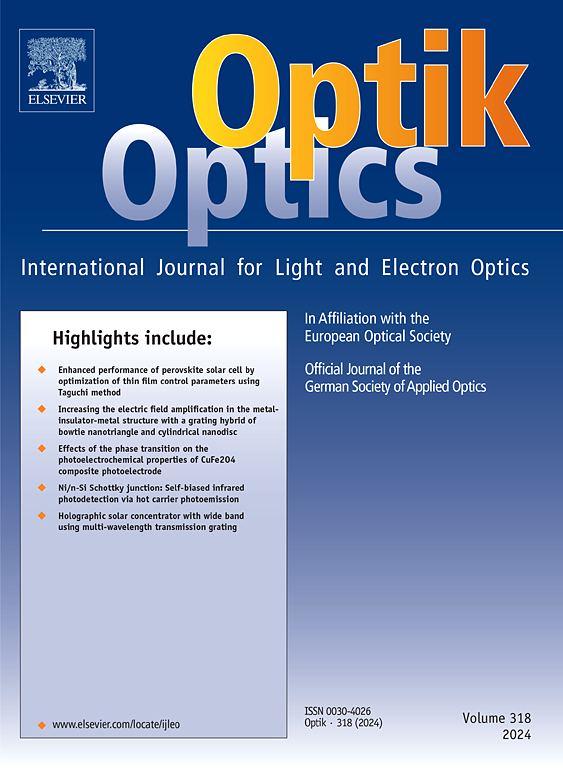Optimization of plasmonic Al/TiO₂ thin film characteristics via scanning pulsed fiber laser deposition
IF 3.1
3区 物理与天体物理
Q2 Engineering
引用次数: 0
Abstract
The deposition method of perovskite solar cell layers significantly impacts device functionality and the achievement of industrial goals. Aluminum (Al) nanoparticles with rutile titanium oxide (TiO2) nanoparticle thin films are fabricated on Fluorine Tin Oxide (FTO) glass substrates by nanosecond pulsed fiber laser deposition (PLD) to be used as a plasmonic electron transport layer (ETL) in perovskite solar cell (PSC). The effect of various pulsed fiber laser parameters on the structural, optical, and surface morphology on Al/TiO2 films is extensively examined utilizing a variety of measurement techniques; X-ray diffraction (XRD), Ultraviolet–visible (UV–Vis) spectroscopy, Field emission scanning electron microscopy (FE-SEM) and Atomic Force microscope (AFM). XRD demonstrates that Al/TiO2 thin films has a mixed phase (anatase/rutile). The minimum average crystallite size of Al/TiO2 thin films deposited at (2 W - 40 kHz) is (19.8 nm). The absorption spectrum of the deposited Al/TiO2 thin film at (10 W - 20 kHz) shows a red-shifted absorption peak at 316 nm, while 307 nm is detected at (2 W - 20 kHz). As the pulse repetition rate rise (40, 60 kHz), a new absorption peak in the UV spectral region at 341 nm was observed. FESEM images demonstrate the nanoparticles’ uniformity and polycrystalline nature. The shape of nanoparticles becomes more uniform and smaller size when the power increases. The minimum power required to get a uniform film is 0.8 W nm with suitable thickness of 398.8 obtained by fitting the thickness values curve of Al/TiO2 thin films. The elemental analysis examined by the EDX spectrum of Al/TiO2 thin films consists of oxygen, aluminum, and titanium. AFM images reveal a granular microstructure, and a flat texture, with the lowest surface roughness. The obtained results from the current study indicate that the structural, optical, and morphological properties can be controlled by varying the fiber laser parameters to deposit an efficient plasmonic Al/TiO2 thin films could be used as an electron transport layer which open new trends to improve the performance of perovskite solar cell.
扫描脉冲光纤激光沉积优化等离子体Al/ tio2薄膜特性
钙钛矿太阳能电池层的沉积方法对器件的功能和工业目标的实现有着重要的影响。采用纳秒脉冲光纤激光沉积(PLD)技术在氟氧化锡(FTO)玻璃衬底上制备了带有金红石型氧化钛(TiO2)纳米颗粒薄膜的铝(Al)纳米颗粒,并将其用作钙钛矿太阳能电池(PSC)的等离子体电子传输层(ETL)。利用各种测量技术,广泛研究了各种脉冲光纤激光参数对Al/TiO2薄膜结构、光学和表面形貌的影响;x射线衍射(XRD),紫外可见(UV-Vis)光谱,场发射扫描电镜(FE-SEM)和原子力显微镜(AFM)。XRD表明Al/TiO2薄膜具有锐钛矿/金红石混合相。在(2 W - 40 kHz)下沉积的Al/TiO2薄膜的最小平均晶粒尺寸为(19.8 nm)。沉积的Al/TiO2薄膜在(10 W - 20 kHz)处的吸收光谱在316 nm处有红移峰,而在(2 W - 20 kHz)处有307 nm的吸收峰。随着脉冲重复频率的增加(40,60 kHz),在341 nm处紫外光谱区出现新的吸收峰。FESEM图像显示了纳米颗粒的均匀性和多晶性。随着功率的增大,纳米颗粒的形状更均匀,尺寸更小。通过拟合Al/TiO2薄膜的厚度值曲线,得到均匀薄膜所需的最小功率为0.8 W nm,合适的薄膜厚度为398.8。EDX谱分析表明,Al/TiO2薄膜由氧、铝和钛组成。AFM图像显示颗粒状微观结构和平坦的纹理,表面粗糙度最低。本研究的结果表明,通过改变光纤激光参数可以控制结构、光学和形态特性,从而沉积出高效的等离子体Al/TiO2薄膜,可以作为电子传输层,为提高钙钛矿太阳能电池的性能开辟了新的趋势。
本文章由计算机程序翻译,如有差异,请以英文原文为准。
求助全文
约1分钟内获得全文
求助全文
来源期刊

Optik
物理-光学
CiteScore
6.90
自引率
12.90%
发文量
1471
审稿时长
46 days
期刊介绍:
Optik publishes articles on all subjects related to light and electron optics and offers a survey on the state of research and technical development within the following fields:
Optics:
-Optics design, geometrical and beam optics, wave optics-
Optical and micro-optical components, diffractive optics, devices and systems-
Photoelectric and optoelectronic devices-
Optical properties of materials, nonlinear optics, wave propagation and transmission in homogeneous and inhomogeneous materials-
Information optics, image formation and processing, holographic techniques, microscopes and spectrometer techniques, and image analysis-
Optical testing and measuring techniques-
Optical communication and computing-
Physiological optics-
As well as other related topics.
 求助内容:
求助内容: 应助结果提醒方式:
应助结果提醒方式:


